|
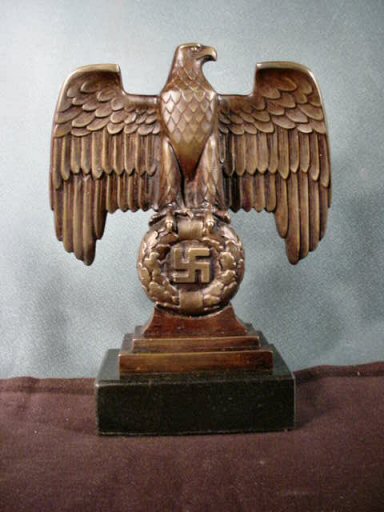
|

|
|

|

|

|

|

|

|
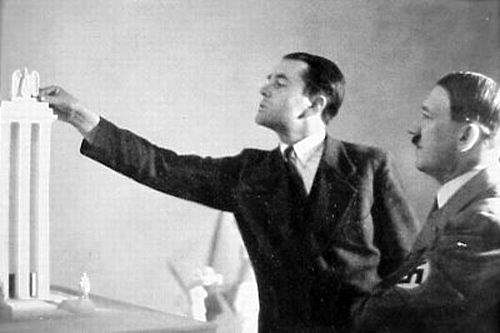
Prof. Speer and Adolf Hitler planning the position of the giant eagle by Ehmens
|
|
Bronze Nuremberg Eagle by Kurt Schmid Ehmen (Item ART 9-1; PARTY 2-10; BRONZE 1-4)
|
DESCRIPTION: Here is one of the greatest finds for Germania International, LLC for 2005. Our specialty has always been to have our pickers in Germany investigate various companies that produced objects such as jewelry, insignia, and art during the Third Reich era. As a result they have turned up some wonderful finds. In this case we located a company known as Preussische Bergwerks u. Hütten AG. It was located in the outskirts of Berlin in the community of Gleiwitz, a town known for iron and bronze art pieces through hundreds of years. Many fantastic pieces of iron and bronze objects d’art were manufactured there between 1813 and 1815. For instance, more than eight thousand Iron Crosses for the heroes who fought against Napoleon were forged in the Gleiwitz foundries. The design was by Karl F. Schinkel. Adolf Hitler mentions the “iron of Gleiwitzer” in the ‘table-talk book,’ page 656. The Kunstguss company that our German associates and researchers found for us and visited was falsely accused of using slave labor in 1945 at the “STAR Chamber Proceedings” in 1945. Many Third Reich items of art were produced by Kunstgiessereigleiwitz and especially by Hütten AG. One of the most often seen in fine collections and museums is the very famous Nuremberg Eagle as designed and sculpted by the famous Third Reich sculptor Kurt Schmid Ehmen, October 13, 1901-July 14, 1968.
He was a world-renowned artist in bronze and stone. The listing of his works in the Third Reich period are legion to include the famous eagle to commemorate the martyrs of the November 9th Putsch at the Feldherrenhalle in Munich, the national eagles on the Führerbau in the Königsplatz, and even the eagles in stone for the four corners of the congress building of the German museum in Munich (they can still be seen today). The wonderful eagle that was to be seen on Der Haus der Deutschen Kunst in Munich and the golden eagle that topped the German pavilion at the Paris World’s Fair were executed by Ehmen. Today all that remains of his monumental work are the four eagles on the museum in Munich. Now we have unearthed what can be considered a tribute to this prolific and dedicated artist and this utterly fantastic discovery takes the form of several solid-bronze editions of the most famous of the Ehmen masterpieces, “The Tribune Eagles” from the Nuremberg Parteitag grounds. These wonderful sculptures are desk eagles that were bought at a fairly high price in their day to be given as gifts to the faithful to the N.S. ideals. The bronze editions cost much more than the more common examples in Weissmetal (white metal or zinc). These pieces were an expensive souvenir, but they were souvenirs not made for any official party function. The detail is great considering the casting process. Yes, they were made in Gleiwitz by the thousands, but today are extremely rare considering the de-Nazification process put in place by the ‘winners’ and the leftist postwar government of Germany. The company officials who sold these pieces just couldn’t bear to see these little gems of history destroyed and that without further adieu is the precise reason that you would have had the chance to acquire one of these Schmid Ehmen eagles to grace your collection. The span of the wings is 6 inches. The height of the sculpture is 7 inches with another 1 1/4 inches for the base. The bases are done with the utmost care and are exactly the same stock provided and used in the 1930s and 1940s. Some of the eagles had to have the patina refurbished to have once again the glorious finished patina. This Deutsch-Adler is without a doubt one of the most impressive art pieces in Third Reich sculpture. This more than any other artistic creation personified the Geist (spirit) of the National Socialist Bewegung (movement and ideals). In our supporting documentation we present for your historical information some images of previously unpublished photographs of the designing and construction of the original monumental Nuremberg Eagles and images of other Ehmen works. The pictures are from an original album having belonged to Herr Ehmen. In this album he showed photographs of various projects such as the planning and construction of the Mahnmal at the Feldherrenhalle, the magnificent eagles over the entrances of the Führerbau and Parteibau at the Königsplatz in Munich and there were many photos of his most grand project, the Tribune Eagles of the Luitpold Arena at the Nuremburg Party Rally grounds. Those eagles were destroyed in an act of cultural vandalism. Now, although smaller, the Ehmen eagles once more emerged not in the cheaper version in Weissmetal, but in glorious bronze just like the originals at the glorious Reichsparteitags der NSDAP. All the original eagles that we had were previously sold and now we were lucky enough as of May 2015, to have exact copies made to exact proportion and exact detail.
PRICE: SOLD
|
 Back view
Back view |
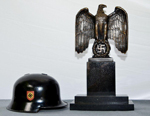 Helmet is for viewer
Helmet is for viewer
perspective only |
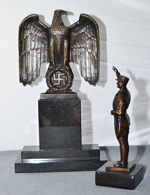 Interesting combination presented
Interesting combination presented
for artistic appreciation |
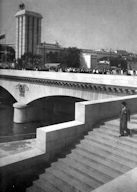 |
|
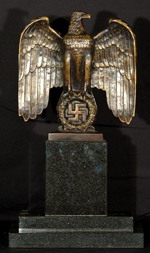 |
Kurt Schmid Ehmens Bronze Sculpture of the Magnificent Eagle of the German Pavilion at the 1937 World’s Fair in Paris
(Item ART 9-1A; PARTEI 2-11 & BRONZE 1-5) |
DESCRIPTION: Earlier on these pages, in the description of the Nuremberg Tribune Eagles by the artist Kurt Schmid Ehmen you will have read about our fortunate discovery and purchase of several of those wonderful eagle sculptures that were cast in the late 30’s and early 40’s at the Preussische Bergwerks u. Hutten A.G. in their Gleiwitz Foundries near Berlin. The artist, of course, of this eagle was none other than Herr Kurt Schmidt Ehmen (1901-1968). You can read about him and the Bergwerks foundry in the narrative at PARTEI 2-10 (above). Ehmen was the “Adlermeister” of the Third Reich and you can see mention of many of the most famous sites throughout the Reich where his sculpted masterpieces were displayed. We have cited several places that the National Socialists considered sacred or sacrosanct and the works of this artist were effectively employed, the list is most impressive. This Adlermeister or ‘Eagle Master’ was considered one of the finest bronze sculptors of Germany and right up there in the ranks of Arno Brecker and Josef Thorak.
After the Party Congress eagles were unveiled and presented to the German public there was a huge demand for artistic renditions of them. The Nuremberg eagles were produced in zinc castings, bronze sculpture, and even sometimes in wood by the Black Forest carvers in the Alps. They were sold as souvenirs throughout the Reich especially at the stores in Nuremberg and surrounding areas at the time of the rallies and the ones that were in bronze by the Bergwerk u. Hutten were considered the best! They were definitely high-end souvenirs and were not made for any particular Party group or function. They were really quite costly in their day. Compared however to the white metal figures made mostly in Bavaria, they cost much more but were really superior in design and general good looks. Very dramatic in design. There was one sculpture however by Schmidt Ehmen that artistically exceeded the Tribune Eagles and that was the lofty, resplendent eagle that was created to be on the top of the Great Exhibition Hall in the German pavilion of the 1937 Paris World’s Fair. This was the absolutely majestic edifice designed by Albert Speer, Hitler’s great ‘Architect Extraordinaire’ and it was Kurt Schmid Ehmen who Speer commissioned to design and build the giant eagle that was seen dominating the view over all of the exhibition grounds. The power and majesty of this tower and this eagle figure were extremely awesome. At one point in time we had in our possession a scrapbook that belonged to the family who were the owners and proprietors of the Prussian Bergwerk u. Hutten AG. The family had collected photographs of the construction of the famous Paris eagle and also some great ones of the artist himself and his crew at work. There was also a great photo of the German Führer Adolf Hitler as he views two Schmidt Ehmen eagles along with architect Speer, prior to the finished masterpieces being erected.
Now in a much more limited number thanks to our picker we received four of the Paris Exhibition bronze models that were produced at Gleiwitz at the same time as the Nuremberg eagles. The Paris eagle is much larger, bolder and a bit more detailed and although at first glance it looks very similar it is decidedly different and of course mounted much differently. With the gorgeous three tier marble base, the sculpture measures almost 20 inches high. The bronze eagle by itself is 10 inches high and 10 inches across the wing span. The base is in three separate marble tiers, The largest standing vertically that directly supports the eagle stands at 6"x 5" and 2 inches thick. The next horizontal piece of marble that the above marble piece is standing on is 9 x 3 inches and the bottom plinth is 11 inches long and 1 inch thick. The piece weighs a “heavy” 33 pounds. It is our opinion that this eagle has to just about be one of the finest and greatest relics of the Third Reich. There are items that are even rarer and certainly more expensive but when I think of the typical aesthetic style of the Thousand Year Reich, the first things that come to mind that reflect all the glory and power present at that time, would be the 1936 officers dagger with chain hanger and the Kurt Schmid Ehmen eagle. Nothing to me is in the end, more purely National Socialist.
The Bergwerks foundry did not produce marble. That material had to be obtained back then at a nearby quarry firm near Gleiwitz. So everything was as it should have been and as it was in the Third Reich. The color, the size, the construction of the base is done to perfection and the marble or granite is in fine jet-black perfect stone. So in essence, the entire first sculptures were 100% original. The eagles are unsigned. The only one that we encountered signed was the pilot piece, and we think it was the single exception.
We want to make it clear that no company still in existence today officially sold us these first eagles...they were bought from the relative of a onetime company official who was able to preserve them in secrecy all these years and now thought they should be out there in the collector and museum world. This eagle would make the ultimate center piece of any fine collection. Here is a noble bird that commands respect and dignity and could be the most overpowering item in your house other than possibly “the little lady”!
PRICE: SOLD
|
|
|
|
Stunning Bronze Statue (Item ART 9-2; OLD 1-6)
|
| DESCRIPTION: This equestrian bronze study is as dramatic as they come. It depicts a Barbarian warrior who has captured the ultimate trophies of was as he casually rides his great steed back to his forest home. He may be of the tribe of Ostrogoth, Vandal, Visagoth, or even the Teutons of Cheruski fame. In any case he is the mighty warrior of the Barbarian period. From his clothing and helmet he is perceived to be a leader or chief. Such a leader was chosen by the other warriors for his fitness to lead them in war. The warriors in turn swore allegiance to their chief. Obviously Germanic by his long, braided hair style and Teutonic-style sword, he is no Hun (who were oriental). His shield is also an indication of his nationality and rank. He does not hesitate to display the trophies he has fought for and won. The most obvious is the damsel who is slung over his mount’s rear. She struggles to no avail. She will be sold into slavery or if comely enough, she may end up being the wife of this conqueror. Hanging from the animal-skin saddle blanket on the left side is the severed head of one of the tribal leaders of the enemy. This is a rather grisly trophy, but was quite customary in that dark age of brutal warfare. It did not pay to let your guard down in those days. Be vigilant and don’t lose your head! From the horse’s snout to the tip of his tail is about 20 inches. From the bottom of the base to the warrior’s helmet top is 17 1/2 inches. The base is 15 1/2 inches by about 6 inches. The artist was working in the Salon de Beaux Arts (Beautiful Art) in Brussels and Paris. Jules-Edmond Masson was a very famous sculptor who was the man who sculpted the famous statue of Napoleon Bonaparte mounted on his horse. Masson worked in Paris and Brussels between 1871 and 1900. During the period up to 1914 the French sculptors seemed to favor the Celtic and Germanic warriors as marshal subjects. This is an extremely rare subject and is historically important. It is the dream acquisition of the true Germanophile, for certain. It is a MAN’S STATUE!!! That sums up the warrior spirit of our race and our vengeance against all comers who would defile our customs and traditions. Kommt der Tag der Rache!
PRICE: SOLD
|
|
|
|
Watercolor by Adolf Hitler (Item ART 9-3; AH 14-4)
|
DESCRIPTION: This original watercolor, done by Adolf Hitler before he came into power, depicts the north side and the unfinished tower of St. Steven's Church in Vienna, and a small part of the Stefansplatz. The watercolor is accompanied by an interesting letter of authentication executed on February 26, 1972. This authentication is done by a Herr Peter Jahn. Mr. Jahn was an expert on Hitler paintings and his specific function during the years of 1937-1944 was to search out and repurchase any of Hitler's works of art that had been executed before his coming into power. (In part because of this, very few of Hitler's watercolors exist.) Hitler apparently felt that because the watercolors were of little commercial value and because of his new position of prominence, he would prefer not to have these works out amongst the public. It was Jahn's specific purpose to seek out and repurchase these watercolors. In his letter, he is specifically familiar with this painting. In 1939, he indicates an owner of a bank was in possession of it at that time and he attempted to repurchase it. The signature in the lower right hand corner is muted and an attempt was made to remove Hitler's signature, possibly by the owner after the end of the war? Jahn also indicates that over the many years that he examined Hitler's paintings and watercolors, this one was the largest personally known to him. It measures approximately 13 x 18 inches. Other than the stain in the signature area, it is generally in good condition. It is matted and framed in a contemporary frame. Many Hitler paintings have been offered by various dealers over the years, but many were bogus, dubious, or at least questionable. Possibly, some of them were genuine, but without provenance. The only absolute 100-percent accepted provenance would be a painting with letter of authenticity from one of only two men. The first would be the late Dr. August Priesack of Munich, and the aforementioned Peter Jahn, who with his above-mentioned credentials was the number-one expert in the world on AH art. With this painting is the signed expertise by none other than Peter Jahn, who looked at it in 1972. Mr. Jahn in his certificate of authenticity states as follows:
| CERTIFICATE OF AUTHENTICITY for an original water colour by the hand of Adolf Hitler. This picture is signed A. Hitler and shows the northside (sic) and the unfinished tower of the St. Stephen’s Church in Vienna and a small part of the “Stefansplatz”. The size is 46 x 34.5 cm which being exceptionally large, is quite unusual. It is the largest of his paintings known to me. The owner of this picture consulted me some time ago as he wanted to have it expertised. The painting is known to me since the year of 1939, when it was shown to me by the owner of a bank, in whose possession it was at that time. I reported the same picture as being found to [from] the “Braune Haus”, but at that time the owner did not want to sell. I still can remember the original signature very well and even now one can easily recognize it. After the war, somebody must have tried to wash out the signature but because of the age of the colour, this was not completely accomplished. To my best knowledge I certify that this picture is an original. To my person: I’m an expert for Hitler’s paintings as from the beginning of 1939 until 1944 I searched for Hitler paintings in Austria by order of the “Braune Haus”. Hitler wanted to rebuy his paintings, as they were of little commercial value and he wanted to have them out of circulation. After the war I was consulted by many people who wanted expertises. Most of the pictures are not for sale. I was mentioned in a German illustrated newspaper a (sic) being an expert for these kind of pictures. I think that now I am the last living expert as my former co-workers have died or their whereabouts are unknown. My collection of photographs of Hitler’s pictures is probably the largest known. I am very well acquainted with the technique of his way of painting and I am certain, that the above mentioned aquarelle is truly an original.”Vienna, 16th February 1972 /s/ Peter Jahn> |
At Germania we strive always to bring you, the collector and historic connoisseur, the finest of relics of Teutonic importance. We could hardly match this one even if we tried as Herr Jahn has indicated this particular Adolf Hitler watercolor is exceptionally large and Jahn says it is the largest one known to him and that is saying something since probably 90 percent of these paintings were viewed by him at one time or another. Small paintings half that size, even without proper provenance, have brought very high prices, while Jahn- or Priesack-provenanced paintings in much smaller sizes have brought astounding prices at auctions. In 1985, the author Billy F. Price wrote a book called Adolf Hitler, The Unknown Artist. In this book Price, along with many prestigious researchers worked diligently to gather as much information about Hitler’s art as could be amassed. Mr. Price is a multimillionaire and he left no stone unturned regardless of expenditure to bring this wonderful informative book to print. Price made many contacts among Hitler’s surviving friends and persons who worked in the many governmental facets of the NSDAP and Wehrmacht witnesses of the Reich and its art forms. The 260-page coffee-table book is vastly replete with paintings, drawings, and other forms of art that have connections or were actually created by the German Führer. The artist was always inspired by the towering edifice of St. Stephen’s Cathedral (Dom) and on pages 138 and 139 there are 11 views of this magnificent House of God to include the very one we offer here. Price has given it the number ‘211’ and states that this is “St. Stephen’s Cathedral—the north side with unfinished tower, 1910-12 watercolor 46 x 34.5 (18 x 13.5 inches) sig. l.r. “A. Hitler.” Only one other of the cathedral is almost as large as this and it is the one pictured next to it described as “St. Stephen’s from the Stock-im Eisen Square 46.8 x 31.6.” For investment we could not even think of an item as prestigious or as historically important as this painting and with this totally unassailable provenance this has to be one of the greatest items we have ever had the great privilege and honor to present on Germania pages.
PRICE: NO LONGER AVAILABLE
|
|
|
|
Book Nordisches Blutserbe (Nordic Blood Inheritance) by Willrich (Item ART 9-4; NSD 10-3)
|
| DESCRIPTION: Here is one of the rarest and most sought after cultural books of the Third Reich with 36 color pictures by Wolfgang Willrich. There are also 28 black and white illustrations as well. There is a foreword by the Reichsbaurenführer (National Farming Leader) R. Walther Darré. It was copyrighted and printed in 1938. The book is ultimately important in the sense that it shows the face of the German Third Reich’s true agricultural importance, but at the same time depicts the face of the Germanic race in its strongest and purest form. The resolute determination and Aryan ideals that seem to emanate from the physiognomy of the men tell the tale of Teutonic greatness through the ages. The purity and astounding beauty of the woman portrayed by Willrich transcend even the goddesses. Wolfgang Willrich was the finest of all the Third Reich artists in his portrayals of human faces and costume. No one came close; not even any of the other great German artists of the past or during the Third Reich; a Reich know for realism in artistic interpretation. These faces of simple but noble farm folk say it all as to what it was that German soldier fought so hard, so bravely to preserve. It is Deutschtum, the spirit of Volkstum; Europe’s hope and ideal possibly still redeemable! The book has 64 pages and the size is 7 x 9 inches. The condition is excellent plus. This is an archival treasure personified?
PRICE: SOLD
|
|
|
|
Mosaic of Nazi Eagle (Item ART 9-5; NSD 10-9)
|
| DESCRIPTION: This is one of not only the largest and heaviest Nazi relics ever brought from Europe after the war, but perhaps the most beautiful, as well. Its historical importance is obvious in that it is the official mosaic made for the grand opening of the Winter Help Work Program. This mosaic is comprised of 20,000 individual gold-colored and other-colored tiny tiles. Before the Wall went down, it was forbidden to bring out any Nazi articles from East Germany. Sounds like ebay, right! This was a communist law! An enterprising West-German antique dealer thought it should be removed from the red-terror regime so he disguised it under an 18th Century mirror, paid the export fee, and moved it through checkpoint Charlie "sweating blood" as he did. Now it's in the West and still forbidden as far as groups like ebay are concerned. This piece weighs in excess of 50 pounds. We have had a special carrying case constructed for it. The magnificent Object der Kunst is signed by the firm of August Wagner in Berlin-Treptow on one of the single tiles. It is approximately 4 x 5 feet in size (big). The Winter Help Eagle is in full detail with the swastika wreathed in green and tan leaves. The most incredible feature of this offering as to provenance is the fact that we include a picture from the Kolnische Zeitung, magazine, that shows this magnificent piece actually being constructed. Unfortunately, the antique dealer in his excitement lost the original magazine, but had photographed the cover and page. The Winterhilfswerk, or WHW, was a charitable collection that held annual drives to help people that were still unemployed in the early Party days. Once a year on a Sunday, all Nazi organizations were expected to make their personnel available for an extensive street collection. High functionaries of the Party as well as screen stars appeared at centrally located spots in the cities to collect money for the fund. Many of the little decorative pins we see in plastic, wood, and metal are the decorations given to persons donating to this program. These were worn in the lapel and showed that you gave. The story that came with this piece was that there was also an appeal to the school children of Berlin to donate one Reichsmark of their lunch money each at some point in time toward the WHW program, and for each child donating, one tiny tile was placed. Only 20,000 tiles completed the mosaic and 979,465 marks were collected as the wording below the eagle indicates. This is not only a most impressive and colorful relic of the Nazi regime, but one of the most historically important items ever offered in this field. This magnificent item hung in a museum display for over 15 years.
PRICE: SOLD
|
|
|
|
SS-Volkskunst Box (Item ART 9-6; SS 23-9; AHN 2-19)
|
| DESCRIPTION: Here is a beautiful little box carved and constructed by hand. Everything about it suggests connection to the Deutsches Ahnenerbe Stiftung: from the Hagel runes to the symbolic Wotan knots. In the top design in the front are the SS runes in one panel, while in the other is the non-mobile Hakenkreutz (swastika). This usually dates somewhere back in the Kampfzeit, although not necessarily so. The box measures across the top 9 3/4 inches x 5 1/4 inches. The lid is longer than the box itself and measures 8 3/4 x 5 inches. The small handles are of brass. This is true SS-inspired Volkskunst (art of the people) and is 100 percent all original. It looks very much like some of the chests that appear in the N.S. magazines like Fraunwarte and Kunst in Deutschen Reich. This is a very fine Kulturstuck and museum piece.
PRICE: SOLD
|
Contact Us
Please refer to item designator in parentheses in all correspondence.
Please E-mail for any additional information you may need.
If you prefer, contact 'Germania' at PO Box 68, Lakemont, GA 30552
or call at 706.782.1668.
Please! do not call during the wee hours of the morning. The best time for calling us is between 9 and 11 am and between 9 and 11 pm eastern time.
|

![]()
